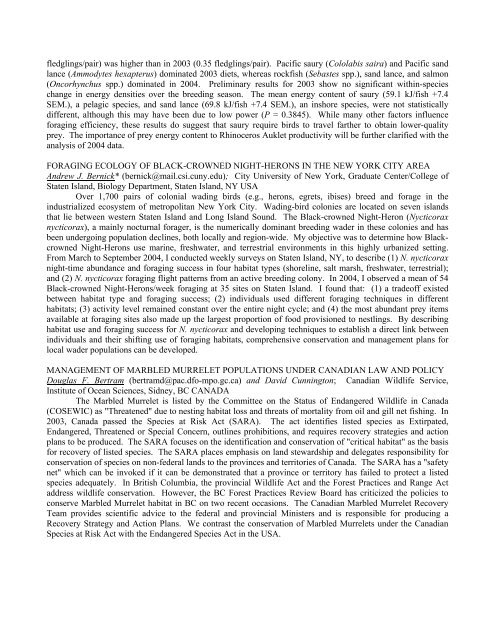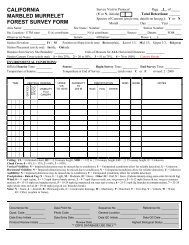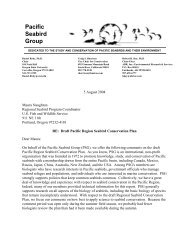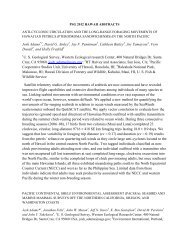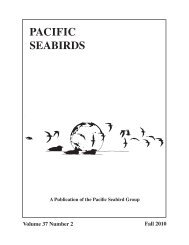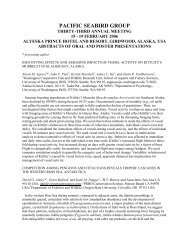abstracts of oral and poster presentations - Pacific Seabird Group
abstracts of oral and poster presentations - Pacific Seabird Group
abstracts of oral and poster presentations - Pacific Seabird Group
You also want an ePaper? Increase the reach of your titles
YUMPU automatically turns print PDFs into web optimized ePapers that Google loves.
fledglings/pair) was higher than in 2003 (0.35 fledglings/pair). <strong>Pacific</strong> saury (Cololabis saira) <strong>and</strong> <strong>Pacific</strong> s<strong>and</strong><br />
lance (Ammodytes hexapterus) dominated 2003 diets, whereas rockfish (Sebastes spp.), s<strong>and</strong> lance, <strong>and</strong> salmon<br />
(Oncorhynchus spp.) dominated in 2004. Preliminary results for 2003 show no significant within-species<br />
change in energy densities over the breeding season. The mean energy content <strong>of</strong> saury (59.1 kJ/fish +7.4<br />
SEM.), a pelagic species, <strong>and</strong> s<strong>and</strong> lance (69.8 kJ/fish +7.4 SEM.), an inshore species, were not statistically<br />
different, although this may have been due to low power (P = 0.3845). While many other factors influence<br />
foraging efficiency, these results do suggest that saury require birds to travel farther to obtain lower-quality<br />
prey. The importance <strong>of</strong> prey energy content to Rhinoceros Auklet productivity will be further clarified with the<br />
analysis <strong>of</strong> 2004 data.<br />
FORAGING ECOLOGY OF BLACK-CROWNED NIGHT-HERONS IN THE NEW YORK CITY AREA<br />
Andrew J. Bernick* (bernick@mail.csi.cuny.edu); City University <strong>of</strong> New York, Graduate Center/College <strong>of</strong><br />
Staten Isl<strong>and</strong>, Biology Department, Staten Isl<strong>and</strong>, NY USA<br />
Over 1,700 pairs <strong>of</strong> colonial wading birds (e.g., herons, egrets, ibises) breed <strong>and</strong> forage in the<br />
industrialized ecosystem <strong>of</strong> metropolitan New York City. Wading-bird colonies are located on seven isl<strong>and</strong>s<br />
that lie between western Staten Isl<strong>and</strong> <strong>and</strong> Long Isl<strong>and</strong> Sound. The Black-crowned Night-Heron (Nycticorax<br />
nycticorax), a mainly nocturnal forager, is the numerically dominant breeding wader in these colonies <strong>and</strong> has<br />
been undergoing population declines, both locally <strong>and</strong> region-wide. My objective was to determine how Blackcrowned<br />
Night-Herons use marine, freshwater, <strong>and</strong> terrestrial environments in this highly urbanized setting.<br />
From March to September 2004, I conducted weekly surveys on Staten Isl<strong>and</strong>, NY, to describe (1) N. nycticorax<br />
night-time abundance <strong>and</strong> foraging success in four habitat types (shoreline, salt marsh, freshwater, terrestrial);<br />
<strong>and</strong> (2) N. nycticorax foraging flight patterns from an active breeding colony. In 2004, I observed a mean <strong>of</strong> 54<br />
Black-crowned Night-Herons/week foraging at 35 sites on Staten Isl<strong>and</strong>. I found that: (1) a trade<strong>of</strong>f existed<br />
between habitat type <strong>and</strong> foraging success; (2) individuals used different foraging techniques in different<br />
habitats; (3) activity level remained constant over the entire night cycle; <strong>and</strong> (4) the most abundant prey items<br />
available at foraging sites also made up the largest proportion <strong>of</strong> food provisioned to nestlings. By describing<br />
habitat use <strong>and</strong> foraging success for N. nycticorax <strong>and</strong> developing techniques to establish a direct link between<br />
individuals <strong>and</strong> their shifting use <strong>of</strong> foraging habitats, comprehensive conservation <strong>and</strong> management plans for<br />
local wader populations can be developed.<br />
MANAGEMENT OF MARBLED MURRELET POPULATIONS UNDER CANADIAN LAW AND POLICY<br />
Douglas F. Bertram (bertramd@pac.dfo-mpo.gc.ca) <strong>and</strong> David Cunnington; Canadian Wildlife Service,<br />
Institute <strong>of</strong> Ocean Sciences, Sidney, BC CANADA<br />
The Marbled Murrelet is listed by the Committee on the Status <strong>of</strong> Endangered Wildlife in Canada<br />
(COSEWIC) as "Threatened" due to nesting habitat loss <strong>and</strong> threats <strong>of</strong> mortality from oil <strong>and</strong> gill net fishing. In<br />
2003, Canada passed the Species at Risk Act (SARA). The act identifies listed species as Extirpated,<br />
Endangered, Threatened or Special Concern, outlines prohibitions, <strong>and</strong> requires recovery strategies <strong>and</strong> action<br />
plans to be produced. The SARA focuses on the identification <strong>and</strong> conservation <strong>of</strong> "critical habitat" as the basis<br />
for recovery <strong>of</strong> listed species. The SARA places emphasis on l<strong>and</strong> stewardship <strong>and</strong> delegates responsibility for<br />
conservation <strong>of</strong> species on non-federal l<strong>and</strong>s to the provinces <strong>and</strong> territories <strong>of</strong> Canada. The SARA has a "safety<br />
net" which can be invoked if it can be demonstrated that a province or territory has failed to protect a listed<br />
species adequately. In British Columbia, the provincial Wildlife Act <strong>and</strong> the Forest Practices <strong>and</strong> Range Act<br />
address wildlife conservation. However, the BC Forest Practices Review Board has criticized the policies to<br />
conserve Marbled Murrelet habitat in BC on two recent occasions. The Canadian Marbled Murrelet Recovery<br />
Team provides scientific advice to the federal <strong>and</strong> provincial Ministers <strong>and</strong> is responsible for producing a<br />
Recovery Strategy <strong>and</strong> Action Plans. We contrast the conservation <strong>of</strong> Marbled Murrelets under the Canadian<br />
Species at Risk Act with the Endangered Species Act in the USA.


